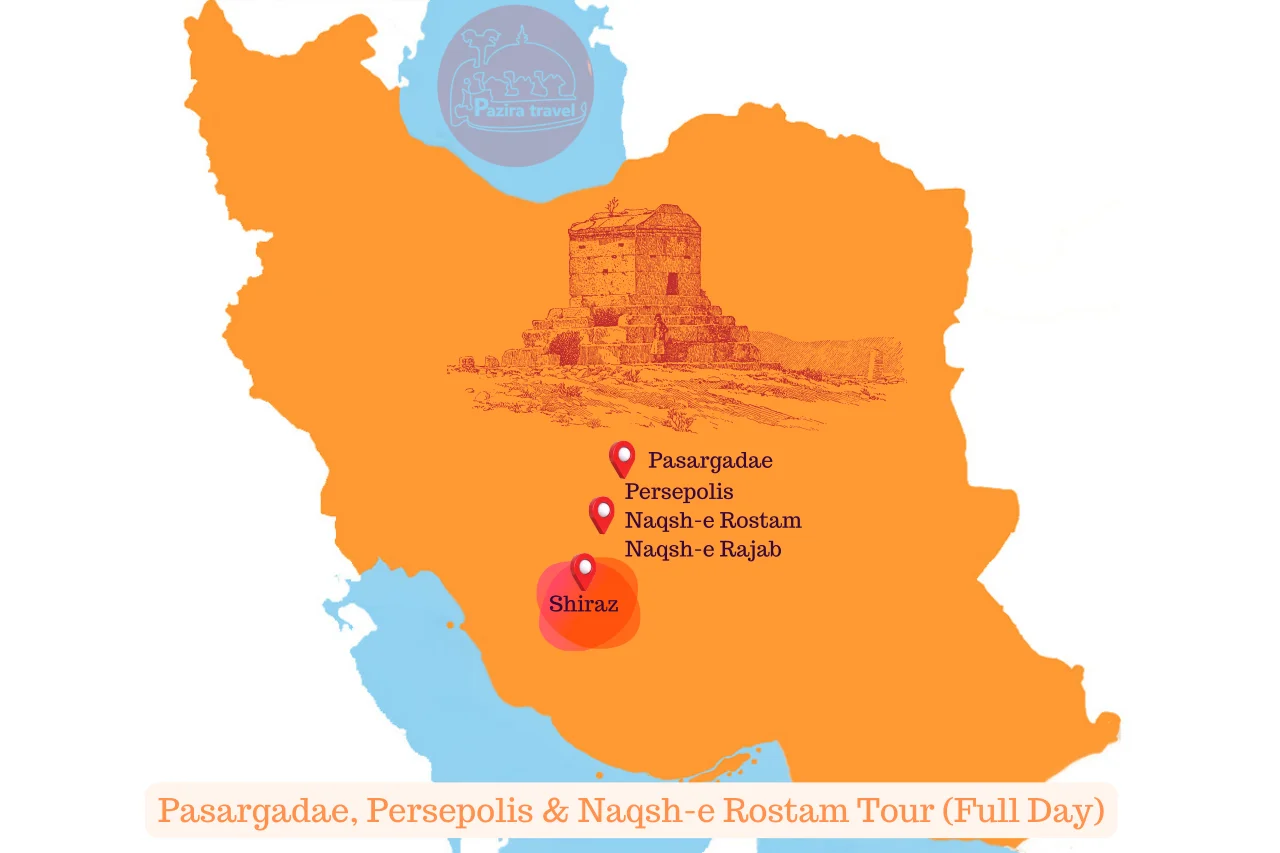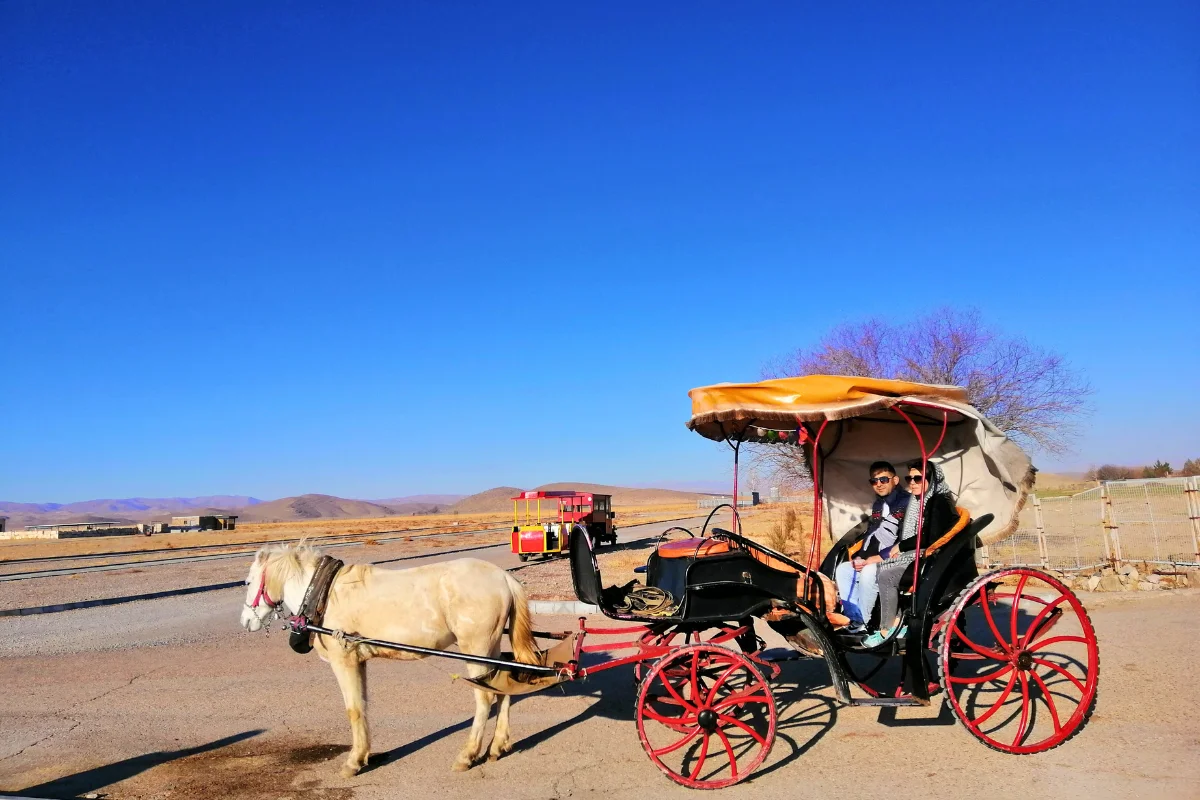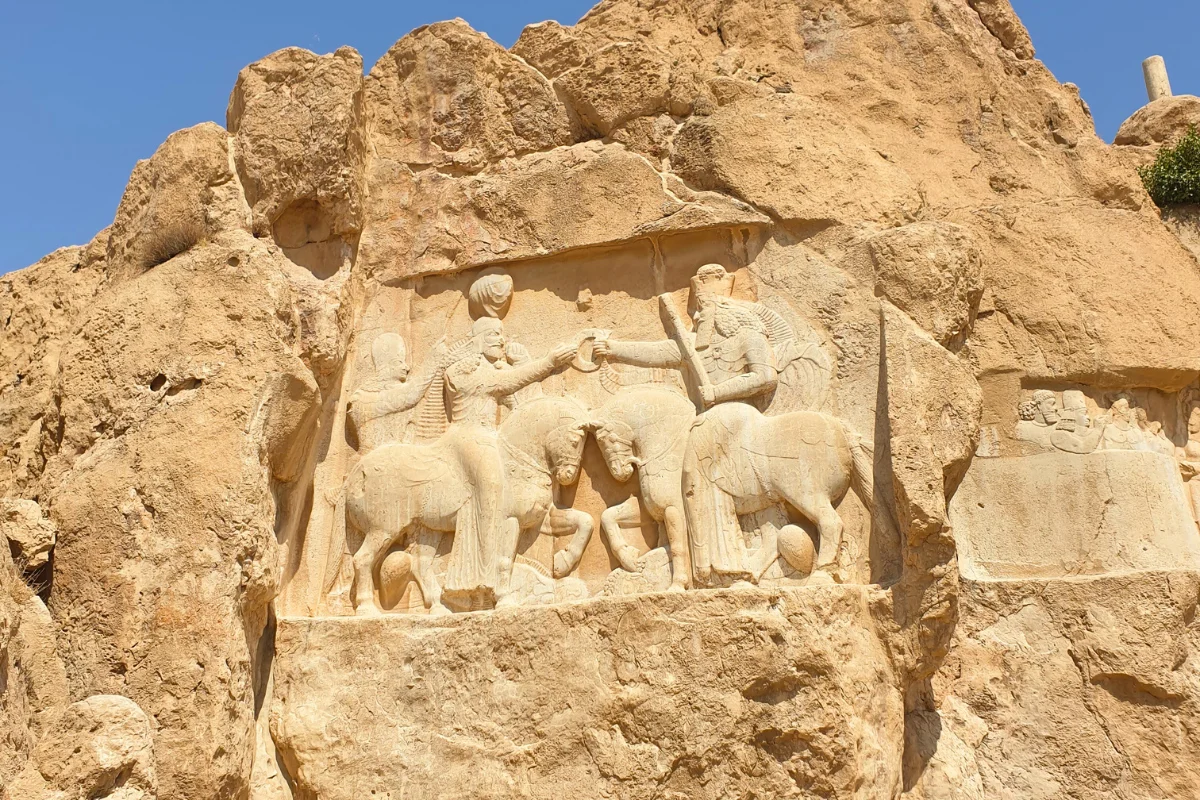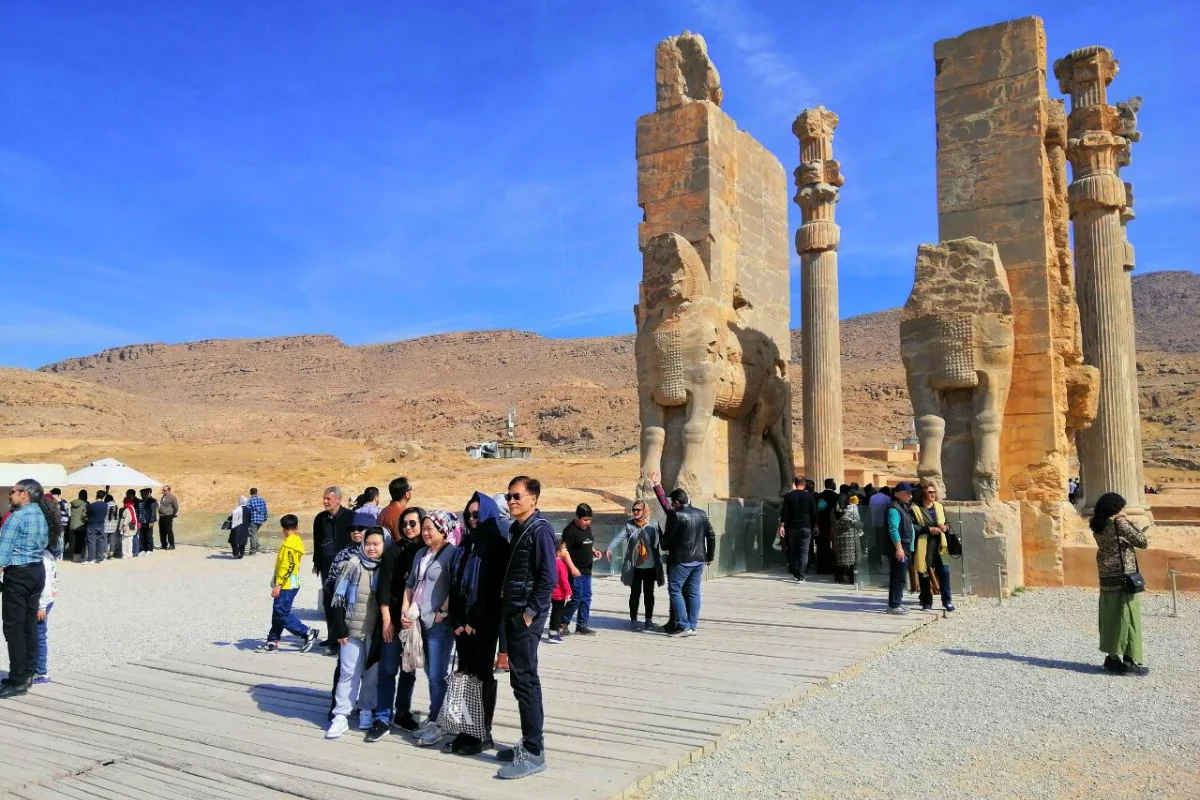Embark on a thrilling full-day adventure from Shiraz, kicking off at 8:00 AM sharp! Get ready to discover the wonders of Persepolis, Pasargadae, and Naqsh-e Rostam. This action-packed tour features stops at Pasargadae, the majestic tomb of Cyrus the Great, Takht Jamshid, Naqsh-e Rajab, and Naqsh-e Rostam. These legendary Achaemenid, Sassanid, and Elamite sites are proudly listed as UNESCO World Heritage gems in Iran. The jaw-dropping grandeur and hidden gems of Pasargadae, Persepolis (Takht-e Jamshid), and Necropolis (Naqsh-e Rostam) sites in Iran are like historical puzzles waiting to be unraveled! Having a savvy guide by your side will turn your visit into a time-traveling extravaganza, helping you unlock their secrets and make the most of every moment. Plus, if you're a photography buff, your guide can sprinkle some magic dust on your snapshots, turning them into unforgettable masterpieces!
- Private Transport
- Tour Guide
- Entrance fee
- insurance
Key Highlights of Persepolis and Pasargadae Tour
Pasargadae: Known as the site where Cyrus the Great rose to power in 529 BC, establishing the Achaemenid Empire which became the world's largest empire. Designated as a UNESCO World Heritage site, Pasargadae encompasses various structures such as the tomb of Cyrus the Great, Darwaza Palace, Reception Palace, Exclusive Palace, kooshks, Pardis Shahi fountains, Cambyses Tomb, Tol Takht defensive structures, and Mozafari Caravanserai.
Persepolis: The construction of Persepolis complex, which was started by the order of Darius I in about 500 years before Christ with the construction of the platform, infrastructure and the first palace, and continued for about 150 years, and each of the Achaemenid kings until the fall of this empire. Alexander the Great built his palace and buildings on this site, and in the construction of this complex, various people and ethnicities of the great territory of the Achaemenid Empire, including artists, workers and engineers, were used, and this complex is a combination of architecture, culture and art. The ancient world has become at that time. The complex of Persepolis, which is one of the buildings registered as a world heritage in UNESCO, is located 57 km from Shiraz, next to Mount Rahmat, near Marvdasht, including the magnificent Gate of All Nations, the Apadana Palace, the Throne Hall, the Tachara Palace, and many other structures that showcase the grandeur and sophistication of the Achaemenid civilization. Each building within Persepolis tells a story of the empire's power, wealth, and artistic prowess. Walking through the ruins of Persepolis, one can feel the echoes of ancient ceremonies, diplomatic gatherings, and royal events that once took place within these walls. The intricate carvings, colossal columns, and majestic staircases speak of a time when Persia stood as a beacon of civilization in the ancient world. Today, visitors from all corners of the globe come to marvel at the splendor of Persepolis, to learn about its history, and to appreciate the ingenuity and creativity of the people who built this extraordinary complex. As the sun sets over the ruins, casting a golden glow over the ancient stones, one cannot help but feel a sense of awe and wonder at the enduring legacy of Persepolis.
Necropolis (Naqsh-e Rostam): Naqsh-e Rostam, a UNESCO World Heritage site, showcases monuments from the Elamite, Achaemenian, Sasanian, and Qajar periods. The site features a variety of reliefs, including those from the Elamian era and the Sassanid era, such as the renowned relief of Ardeshir Popakan. Additionally, it houses the tombs of Achaemenid kings like Darius I, Xerxes, Ardeshir I, and Darius II, along with Zoroaster's Kaaba. This historical complex, situated 6 km from Persepolis, is a captivating and significant site in the ancient city of Istakhr.
The Monuments included in this tour
Persepolis, Pasargadae, Naqsh-e Rostam and Naqsh-e Rajab
Key Tips for Visiting Pasargad, Persepolis, and Necropolis (Naqsh-e Rostam)
- Large bags, suitcases, and similar items are not allowed at Persepolis. If you bring them, you must leave them in the designated area before entering. It's advisable not to bring these items.
- Professional cameras, drones (quadcopters), and their equipment are prohibited within the complexes of Pasargadae, Persepolis, and Naghse Rostam.
- When visiting Pasargadae, Persepolis, Naqsh-e Rostam, and Naqsh-e Rajab, as these sites are outdoors without shelter, it's recommended to use umbrellas, wide-brimmed hats, and sunscreen.
- Since you'll be spending a significant amount of time walking and standing during your trip to Pasargadae, Takht-e Jamshid, Naqsh-e Rajab, and Naqsh-e Rostam, be sure to wear appropriate walking shoes.
- To ensure the tour runs smoothly as a public group tour, make sure to arrive punctually at the meeting point and collaborate with your guide throughout the visit for optimal organization.
- When making a reservation for the tour, provide a contact number for communication purposes.
Frequently asked questions about Pasargadae and Persepolis tour
1. When is the best time to visit Pasargadae and Persepolis based on weather conditions?
The optimal time to explore Pasargadae and Persepolis, considering their sun exposure, is during April, May, September, October, and November. These months offer pleasant weather with minimal rainfall compared to winter. If you don't mind the cold, the winter season is also recommended, excluding rainy days. Daily tours of Pasargadae and Persepolis (Takht-e Jamshid) are available throughout the week except on certain holidays when the sites are closed.
2- How far in advance can you reserve a tour of Pasargad and Persepolis?
You can book daily tours of Pasargadae and Persepolis with Pazira Travel until 10 p.m. the evening before the tour. Alternatively, if you show up at 8 a.m. at the Pazira Travel Company on Rudaki Street near Zand Street, and if there are available spots on the tour, you can join the tour
3- Can tours of Pasargadae and Persepolis be arranged at different times?
Group tours to Pasargadae and Persepolis have set pick-up times daily. However, for a customized tour, arrangements can be made at a time that suits the traveler.
4- In group tours of Pasargadae and Persepolis, how long is dedicated to exploring Pasargadae, Persepolis, Naqsh-e Rostam, and Naqsh-e Rajab?
- Approximately 2 hours for Persepolis
- Approximately 1 hour for Pasargadae
- Around 45 minutes for the Naqsh-e Rostam complex
- Roughly 15 minutes for the Naqsh-e Rajab site.
5- Can you take photos and have free time during the group tour of Pasargadae, Persepolis, and Naghse Rostam organized from Shiraz?
The tour guide for Pasargadae and Persepolis from Shiraz will allow time for photography or leisurely exploration at the end of the visit to Pasargadae, Persepolis, Naqsh-e Rostam, and Naqsh-e Rajab for interested travelers. If you require more time for photography or to explore the sites thoroughly at a slow pace, it is advisable to opt for a private tour of Persepolis.
6- How long does the exclusive tour of Pasargadae and Persepolis last?
An exclusive tour of Pasargadae and Persepolis can range from a single day to multiple days by staying in accommodation complexes near Persepolis, including traditional residences, ecotourism residences, or hotels.
7- When is the best time of day for photographing Pasargadae and Persepolis, Naqsh-e Rostam, and Naqsh-e Rajab?
Different angles for photography are created at various hours of the day due to the diverse orientations of the buildings and bas-reliefs in Pasargadae, Persepolis, and Naqsh-e Rostam complexes. Mount Rahmat in the east of Persepolis allows for sunset photography if the sun sets before closing time during certain months. The Sassanid reliefs and Achaemenid tombs of Naqsh-e Rostam face the south-southeast angle, while the Sassanid reliefs of Naqsh-e Rajab face north and west angles.
8- What types of vehicles are used in the group tour of Pasargadae and Persepolis?
Depending on the number of people on the tour, passenger cars, vans, or buses meeting safety standards and regulations are utilized.
9- Can you join the tour at Persepolis instead of from Shiraz?
It is possible to join the tour on the way from Shiraz to Persepolis (if on the main route, as driving off the route is not possible) or at the entrance of Persepolis by pre-booking the tour. Since the tour is group-based, waiting at the entrance of Persepolis or along the route is not feasible; punctuality is essential.
10- Is the tour guide for Pasargadae and Persepolis specialized in archaeology and architecture of Persepolis?
The guide leading public tours possesses knowledge related to the visited sites, although private tours of Persepolis and Pasargadae with specialized guides such as archaeologists, architects, or historians are available due to the time limitations and the general nature of public tours.





